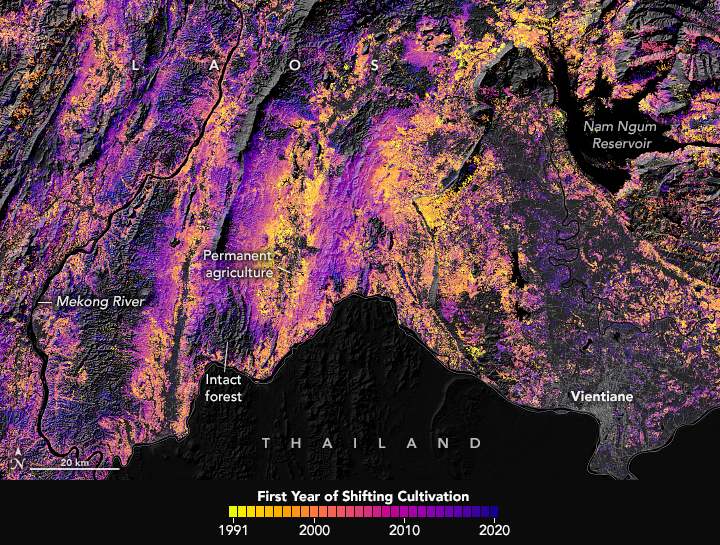
Shifting Cultivation in Laos
Downloads
- laosshiftingcultiv_oli_2020_lrg.jpg (2228x2166, JPEG)
- laosshiftingcultivzm_oli_2020_lrg.jpg (2925x1950, JPEG)
Metadata
- Sensor(s):
- Landsat 5 - TM
- Landsat 7 - ETM+
- Landsat 8 - OLI
- Data Date:
- Visualization Date: August 17, 2023
In developing economies in southeast Asia and the tropics, an agricultural practice known as shifting cultivation is widespread. The process involves clearing land, farming it for a short amount of time, then leaving it fallow to allow soil fertility to recover. In Laos, establishing permanent agricultural land is challenging due to its mountainous terrain and barriers to developing irrigation systems. Much of Laos’s population depends on shifting cultivation, particularly for growing rice.
The reliance on this practice has significantly altered the land cover across the country. A recent study published in Remote Sensing of Environment revealed that shifting cultivation has been the leading cause of forest disturbance in Laos over the past 30 years. Understanding and monitoring this change, the authors argue, can help land managers minimize future impacts of the practice and support the country’s emissions-reduction and forest management goals.
The map above displays the growing footprint of shifting cultivation in Laos over three decades. Areas are colored based on when the land was first cleared for the agricultural practice, with yellows and oranges representing earlier years in the study period and shades of purple indicating later.
A group of scientists led by Shijuan Chen, of Yale University, developed the map by analyzing Landsat data from 1991 to 2020. Transitions from forest to field to regrowth occur relatively quickly and at small scales. By analyzing Landsat data from throughout the study period, the researchers identified a pattern in land cover change that is distinct from other forms of forest disturbance. The team received support from NASA’s Carbon Monitoring System (CMS) and Land-Cover and Land-Use Change (LCLUC) Program to develop and implement their method.
“The area of shifting cultivation in Laos is very large, and much larger than permanent agriculture,” Chen said. She found that shifting cultivation affected 33 percent of the total area of Laos over the course of the study period. Significantly more forest conversions occurred from 2016–2020 compared with previous five-year periods. The authors also reported that all forms of forest disturbance affected 38 percent of the country, making shifting cultivation by far the leading cause.
A closer look at the northern part of the country reveals interesting patterns in land use over time. Northwest of the capital city of Vientiane, shifting cultivation expands from areas adjacent to permanent agriculture toward intact forest to the east and west. Chen suspects this pattern arises when farmers start by cultivating more-accessible land with gentle slopes. “If those places are not large enough to support their activities, they go beyond easy-to-access regions and encroach on dense forests,” she said.
In an extension of their land use change work, Chen and her team quantified the carbon emissions associated with shifting cultivation. They combined Landsat data with observations from NASA’s GEDI (Global Ecosystem Dynamics Investigation) instrument on the International Space Station. GEDI is a lidar instrument that can discern with high precision the structure of forests, which researchers can use to estimate carbon storage.
Applying this technique to Laos’s forests, Chen found that 89 percent of the carbon emissions stemming from shifting cultivation from 2000–2020 came from clearing primary forest. Those results point toward potential ways to improve the cultivation practice, she said. For example, managers may work with communities to find alternatives to clearing high-biomass areas.
Laos has set targets for increasing forest cover to 70 percent of the country’s total area, as well as for reducing emissions from deforestation and forest degradation. Minimizing primary forest loss from shifting cultivation may be an important part of that progress. Food insecurity is also a consideration when it comes to altering agricultural practices. Laos is simultaneously charting a course toward making agriculture, forestry, and fisheries more productive and sustainable.
References & Resources
- Chen, S. et al. (2023) Monitoring shifting cultivation in Laos with Landsat time series. Remote Sensing of Environment, 288, 113507.
- Chen, S. (2022) Satellite-Based Monitoring, Attribution, and Analysis of Forest Degradation. Doctoral dissertation, Boston University.
- Food and Agricultural Organization of the United Nations (2015) FAOLEX Database. Accessed August 17, 2023.
- NASA Earth Observatory (2023, June 29) Protected Areas Safeguard Climate. Accessed August 17, 2023.
- NASA Earth Observatory (2019, April 15) Return of the GEDI’s First Data. Accessed August 17, 2023.
- United Nations Framework Convention on Climate Change (2023) Submissions provided by Lao People’s Democratic Republic (REDD+). Accessed August 17, 2023.
NASA Earth Observatory images by Lauren Dauphin, using data from Chen, Shijuan, et al. (2023). Story by Lindsey Doermann.
This image record originally appeared on the Earth Observatory. Click here to view the full, original record.
